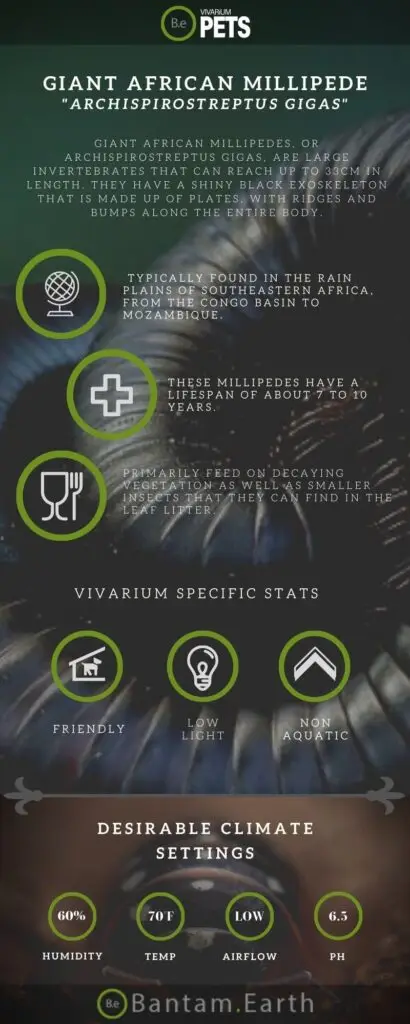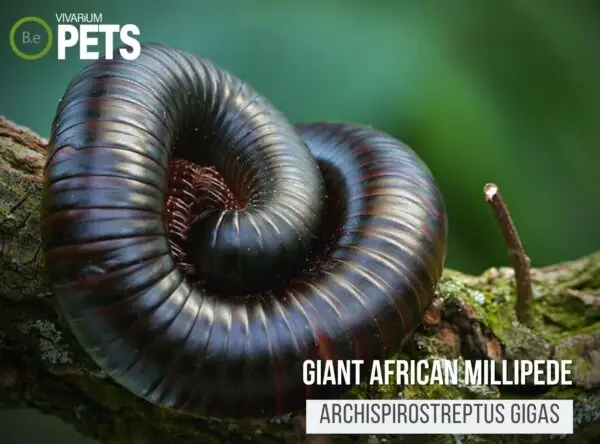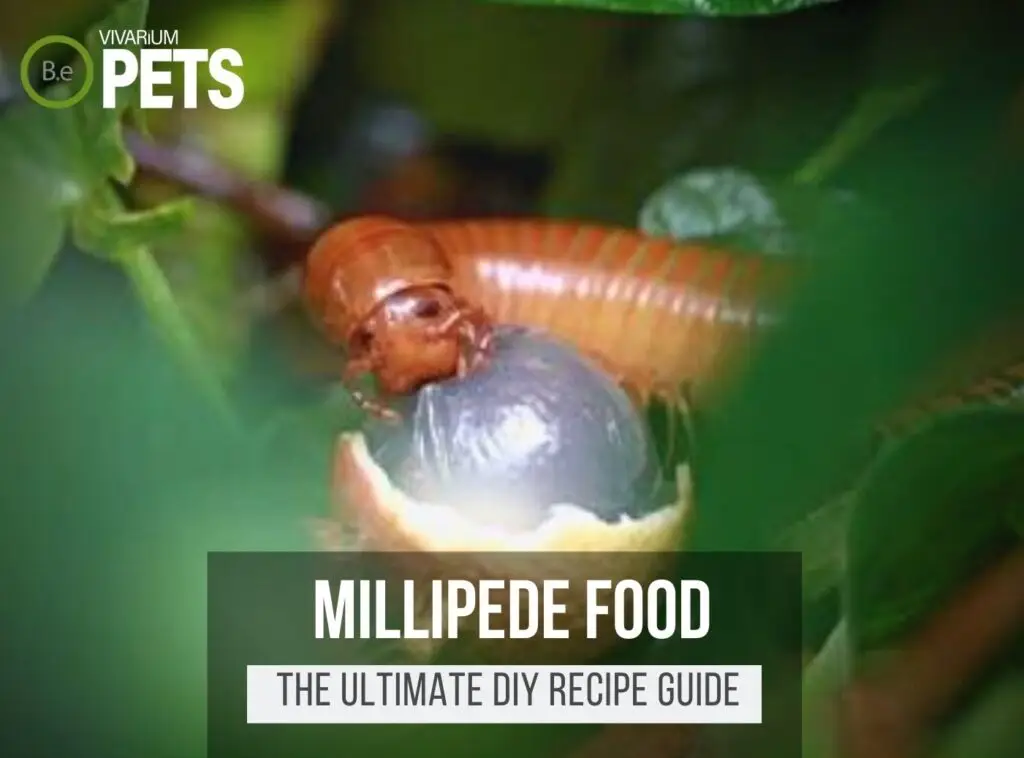Giant African Millipedes, also known as Archispirostreptus gigas, are big, like really BIG!
And although they may appear daunting, they are quite docile creatures.
This article will provide everything you’ll need to know about the massive millipedes, from taxonomy and morphology to housing and health requirements.
This guide will equip you with the knowledge necessary to ensure your African Millipedes are living their best life possible.
| Characteristics: | |
|---|---|
| Common Name | Giant African Millipede, African Giant Black Millipede, Shongololo |
| Family Name | Spirostreptidae |
| Scientific Name | Archispirostreptus gigas |
| Use | Cleaning, Aerating Soil, Pets |
| Temperament | Non-aggressive |
| Lifespan | 7-10 Years |
| Diet | Detritivore |
| Adult Size | 33.5 cm |
| Breeding Type | Egg Layer |
| Care Level | Easy |
| Minimum Tank Size | 15-30 Gallons |
| pH | 5.5 to 7.5 |
| Hardness | Soft |
| Temperature | 60-75°F |
Table Of Contents:
ToggleWhat Are Giant African Millipedes?
Archispirostreptus gigas are invertebrate species belonging to the family Spirostreptidae.
The common name “Giant African Millipede” is derived from the species’ large size when compared to other types of millipedes.
Other common names for this ginormous creeper include African Giant Black Millipede as well as Shongololo, which is what native South Africans call millipedes in Zulu.
What Do Giant African Millipedes Look Like?
Giant African Millipedes are large invertebrates that can reach over 13 inches in length.
They have a shiny black exoskeleton that is made up of plates, with ridges and bumps along the entire body.
These millipedes are thought to possess the longest brownish-orange legs compared to any other species of millipede.
These creatures have two sets of antennae coming out of their head, with each antennae having up to 400 segments.
They also have up to 100 body segments. Each segment contains two pairs of legs and the larger segments have three pairs.
The first pair of legs is situated near the head and are used for sensing.
Archispirostreptus gigas also has two prominent compound eyes.
Benefits Of Using Giant African Millipedes
Giant African Millipedes are a great addition to almost any type of vivarium due to their unique and rewarding care requirements.
Not only can they be incredibly entertaining to observe, but they will also help to keep your enclosure clean and healthy.
These millipedes can act as natural detritivores, eating organic matter and contributing to the cycling of organic and inorganic materials.
They are also ideal for more tropical terrariums with high humidity requirements, as Archispirostreptus gigas need a bit of extra moisture.


Giant African Millipede Facts
Giant African Millipedes are beautiful, docile invertebrates that naturally thrive on a diet of decaying organic matter such as leaves, fungi, and earthworms.
They are native to the central and western parts of Africa and are known to be a symbol of luck in many African cultures.
Generally, Archispirostreptus gigas is a solitary animal and lives in a sheltered burrow or underground tunnel that they have typically dug or constructed.
They come out to search for food at night or during wetter conditions.
Habitat
Giant African Millipedes are native to tropical forests in sub-Saharan Africa, where they live in well-shaded and moist environments.
They stay underground almost all the time, using their impressive 30-foot-long burrow system to move around or hibernate.
During the night, they will come out to feed on decaying leaves, fruits, and bark.
During the day they retreat down their burrows to avoid predators and the heat of the sun.
These millipedes are typically found in the rain plains of southeastern Africa, from the Congo basin to Mozambique.
Because of their nocturnal behavior, they are usually spotted in the early morning or evening hours when the sunlight is low.
Diet
In their native habitats in West and Central Africa, Archispirostreptus gigas are typically omnivores, with diets that mostly consist of decaying plant and leaf matter.
Some species may also consume dead insects and small amounts of soil.
Temperament
Giant African Millipedes are quite gentle and docile creatures, making them great pets for children or novice millipede keepers.
They are not aggressive or predatory and cannot bite or sting.
When threatened, they will curl up into a tight coil to protect their delicate legs, which may be mistaken for aggression.
Millipedes that encounter strange environments may coil up and rapidly move their legs, which may be seen as aggression.
Giant African Millipedes can live in harmony with other animals and are an excellent addition to any pet terrarium or communal tank.
However, it’s not a good idea to house millipedes with other animals that could potentially attack or consume them.
Lifespan
Archispirostreptus gigas have a fairly long lifespan for invertebrates, typically about six to seven years of age.
In captivity, this can be even longer. With good care, an individual may live up to 10 years.
At sexual maturity, which is usually reached at around one year of age, the Giant African Millipede will begin its life cycle.
Females lay eggs in soil or substrate in the home enclosure.
After hatching, the young millipedes usually feed on leaf litter, decaying organic matter, and fresh fruit to promote growth.
The millipede will continue to molt as it grows, becoming larger.
Breeding
Giant African Millipedes mate similarly to other arthropods and insects, with both male and female performing a courtship ritual before mating.
This involves circling each other and rubbing antennae together, as well as touching and exchanging chemical cues through their antennae.
After mating, Archispirostreptus gigas typically lay their eggs on a substrate close to their burrow and the eggs will hatch within two to three weeks.
Once hatched, young millipedes will molt several times as they grow into adults and reach sexual maturity in 8-12 months.
Where To Find Giant African Millipedes
Giant African Millipedes can be found most easily in East and West Africa, although they can be found in other parts of Africa as well.
Within these regions, they prefer to live in warm, moist conditions, such as deep leaf litter, humus, and rotting wood.
If traveling to Africa isn’t on the “to-do” list anytime soon, these creatures can also be found for sale online or at select pet stores.
When purchasing millipedes online, it is important to research reputable breeders or breeders that specialize in Archispirostreptus gigas care.
It is also important to remember that millipedes are fragile and sensitive to the effects of temperature and humidity.
Therefore, it is important to ensure that they are shipped in the correct conditions to ensure their safety and well-being.
Giant African Millipede Care
African Giant Black Millipedes require a specific combination of housing, substrate, diet, temperature, and humidity to stay healthy and happy.
Proper care also includes monitoring for health concerns.
With the right environment and attention, you can successfully breed and care for Archispirostreptus gigas.
Tank Requirements
The ideal tank requirements for Giant African Millipedes are dependent on the type of vivarium they live in.
For example, a paludarium-style tank that can hold both land and water features is ideal.
I suggest a negative to neutral pH value, moderate water hardness, and temperatures ranging from 68 to 82 degrees Fahrenheit.
The terrarium substrate is an important factor to consider as well, as millipedes prefer wood chips, coconut fiber, and peat moss soil with a mixture of mulch or leaf litter on top.
Finally, the lighting for the terrarium should be kept low, as millipedes prefer low lighting and a regular day/night light cycle.
What Do Giant African Millipedes Eat?
Feeding your Giant African Millipedes can be an enjoyable experience.
Even caretakers with little experience can provide these fascinating creatures with a nutritious and varied diet.
Here are some tips for selecting the best foods for your millipedes:
- Offer a variety of fresh fruits and vegetables such as apples, carrots, cucumbers, peppers, and squash.
- Flowers, leaves, and weeds from your garden can also provide nourishment.
- Consider adding a protein source, such as cooked egg yolk, to your millipedes’ diet.
- Nuts, seeds, and grains are also suitable treats that they can enjoy occasionally.
- Supplement their diet with commercial millipede food.
- Make sure to dust their food with calcium powder or vitamin/mineral supplements to ensure their proper nutrition.
Archispirostreptus gigas will show their appreciation by happily munching on their food. With the right diet, they can live long, healthy lives.
If you’re more of an avid hobbyist like myself, be sure to check out my ultimate DIY Millipede food guide. I give a more in-depth explanation of the best foods and my favorite recipe.
Best Tankmates For Giant African Millipedes
When choosing tankmates for your Giant African Millipede, it is important to consider the safety of the millipede as well as its tankmates.
Generally, invertebrates make the best tankmates since they provide similar beneficial qualities.
Good invertebrate tankmates for Archispirostreptus gigas are small snails, isopods, some spiders, crabs, and springtails.
These invertebrates generally require similar care needs for their well-being.
Such friends provide beneficial qualities such as substrate cleaning, while also avoiding conflict with your Giant African Millipede.
Conclusion
In the end, a Giant African Millipede may not be for everyone, but with the right level of dedication, they can make wonderful and rewarding pet millipedes.
With the right care instructions, you can bring a healthy and happy Archispirostreptus gigas into your tank, and we hope you’ve come away from this article with the knowledge necessary to do so.
Frequently Asked Questions
Giant African millipedes are not poisonous to humans but can release a liquid that can be irritating to the skin and eyes.
Handling any type of millipede can cause skin irritation or allergic reaction, so it’s best to avoid handling them unless necessary and wash your hands thoroughly after handling them.
Giant African millipedes are not illegal to own in most places, but they may be regulated or prohibited in some areas due to their potential to become invasive species or carry diseases.
It’s important to check your local laws and regulations before keeping one as a pet.
A tank size of 15-30 gallons is usually sufficient for one or two millipedes.
However, it’s important to provide a suitable habitat with enough space, substrate, hiding places, and moisture for their well-being.
Giant African millipedes are detritivores and primarily feed on decaying plant matter, such as leaves, fruits, and vegetables.
They may also consume calcium-rich supplements, such as cuttlebone or eggshells, to support their exoskeleton growth.
Yes, giant African millipedes are legal to own as pets in the United States, but some states may have specific regulations or restrictions on their ownership.
It’s important to check with your state and local authorities to ensure that it is legal to keep a giant African millipede as a pet in your area.
Giant African millipedes can make good pets for some people, as they are low-maintenance, fascinating to observe, and generally docile.
Giant African millipedes can live up to 7 to 10 years in captivity, but their lifespan may vary depending on factors such as their environment, diet, and genetics.
When handling a giant African millipede, it’s important to avoid picking them up by their legs or pulling on their body, as this can cause them stress or injury.
Instead, gently scoop them up with your hand or a soft-bristled brush and support their body from underneath.
It’s also recommended to wash your hands before and after handling them to prevent the spread of bacteria.
Archispirostreptus gigas, also known as the giant African millipede, has around 256 legs in total, with two pairs of legs per body segment.
However, the exact number of legs may vary slightly depending on the individual’s age, size, and health.

